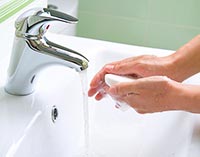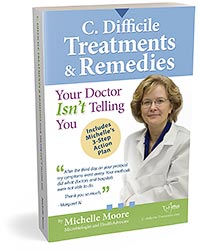
C. difficile spores can survive on household surfaces for months
C. difficile can exist in two different forms: as living cells and as dormant spores. Both the bacteria and the spores come from stools (or feces) that are passed from either an infected person or a C. diff. carrier. The spores are very tough and can survive on surfaces and objects for several months, depending on environmental conditions.
However, in order to cause infection, the bacteria must be transferred into someone’s mouth, which is called fecal-oral transmission. You must swallow the C. diff. bacteria or C. diff. spores in sufficient quantities in order to get infected.
Fecal-Oral Transmission
As hard as it may be to believe, fecal-oral transmission happens more easily and more often than people realize. This is because bacteria from an infected person can easily pass between numerous surfaces or objects before they finally reach your mouth. For example, many people do not wash their hands after using the bathroom, or they wash them inadequately. When they exit the bathroom, they leave bacteria behind on the door handle. You use the bathroom, wash your hands and touch the handle on the way out and then eat dinner without washing your hands first. If your fingers picked up this bacteria or its spores and you then lick your fingers or touch your mouth, you could ingest C. diff. and potentially get infected.
Therefore, bathrooms, toilets and sinks are hot-spots for C. diff. bacteria to hang out. Any high-touch surface can also harbor the bacteria, like door knobs, keyboards, kitchen areas, phones, remote controls, and more. C. difficile can also hang out on clothing and underwear. C. diff. does not spread through the air like a cold or flu can.
How to Reduce Your Risks
The two best defenses you have against becoming infected from C. diff. contamination are awareness and hand washing. Fortunately, both of these preventative measures are simple, effective and cost nothing. The key is knowing the risks and practicing safe, consistent and effective hand washing techniques.
Awareness and Prevention Practices
- If you know someone with C. diff., avoid sharing clothing or personal care items and keep laundry segregated.
- Avoid touching high-risk surfaces. The highest risk surfaces are in public restrooms. Take extra precautions such as using a paper towel to avoid directly touching bathroom stalls and latches, toilet handles, bathroom faucets, paper towel dispensers and door handles.
- Flush public toilets before use. Because C. diff. is in stools, flushing a toilet, even if it has already been flushed, can help reduce the risk of C. diff. being present in the toilet. Put the toilet lid down first (if there is one) to minimize C. diff. or other bacteria being splashed onto the seat when flushing. Starting out with a fresh bowl of water will reduce the risk of contaminated “splash-back” when using the toilet.
- If possible, use sanitizing wipes on high-risk surfaces before touching them as this will help kill some of the bacteria. Surfaces such as shopping cart handles, library computer keyboards, hotel TV remote controls or any other high-touch surface can be easily wiped down with sanitizing wipes that you can carry with you.
- Keep a balanced perspective. Overuse of sanitizers and hand washing with harsh soaps and detergents can have negative consequences for your skin and your immune system. Avoid becoming a “germaphobe” by focusing on the highest risk surfaces and objects.
Hand Washing

Hand washing removes C. diff. spores and other microbes from the skin
- Use soaps and personal care products WITHOUT chemical antimicrobial agents. Read product labels carefully and don’t use soaps with synthetic antimicrobial agents such as Triclosan, Triclocarban, Methylisothiazolinone (MIT), Chloroxylenol (PCMX) and Chlorhexidine gluconate (CHG). Read more about hand washing and antibacterial soaps here: infection control
- Wash your hands with good old fashioned soap and warm water. Soap itself with scrubbing action physically removes C. diff. spores and other germs.
- Scrub hands briskly for at least 15 – 30 seconds, rubbing soapy water to the front and back of the hands, between the fingers and under the nails.
- When away from home, grab a paper towel immediately after you finish washing your hands before turning off the water or touching any high-risk bathroom surfaces. After drying your hands, use the same towel to turn off the water faucet and to open the bathroom door.
- Carry a small bottle of natural hand sanitizer when you don’t have access to soap and water. These are a better alternative to alcohol based sanitizers which once absorbed into the body can suppress immune function.
Keep Your Home and Your Family Safe
 You’ll find detailed methods, tips and techniques for controlling household C. diff. contamination inside the the book C. Difficile Treatments & Remedies. Included are four chapters devoted to hand washing and hygiene methods, cleaning and disinfecting protocols, clothing and laundry techniques, and prevention strategies for the home, hospital and community.
You’ll find detailed methods, tips and techniques for controlling household C. diff. contamination inside the the book C. Difficile Treatments & Remedies. Included are four chapters devoted to hand washing and hygiene methods, cleaning and disinfecting protocols, clothing and laundry techniques, and prevention strategies for the home, hospital and community.
Get Michelle’s book today and start getting C. difficile under control.

About the Author – Michelle Moore, BSc
Michelle Moore is a microbiologist, holistic health educator, and author of C. difficile Treatments & Remedies. With over 10 years of experience in pharmaceutical research and over 20 years in natural medicine, she helps people overcome C. difficile and other chronic infections naturally.


 Fill in the form below to get our C. diff. tips newsletter and your free report “10 Things You Need to Know to Overcome C. difficile”.
We value your Privacy. Your email will be kept strictly confidential & secured. See our
Fill in the form below to get our C. diff. tips newsletter and your free report “10 Things You Need to Know to Overcome C. difficile”.
We value your Privacy. Your email will be kept strictly confidential & secured. See our 
